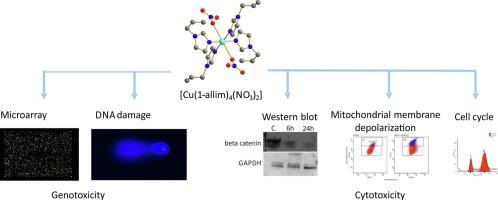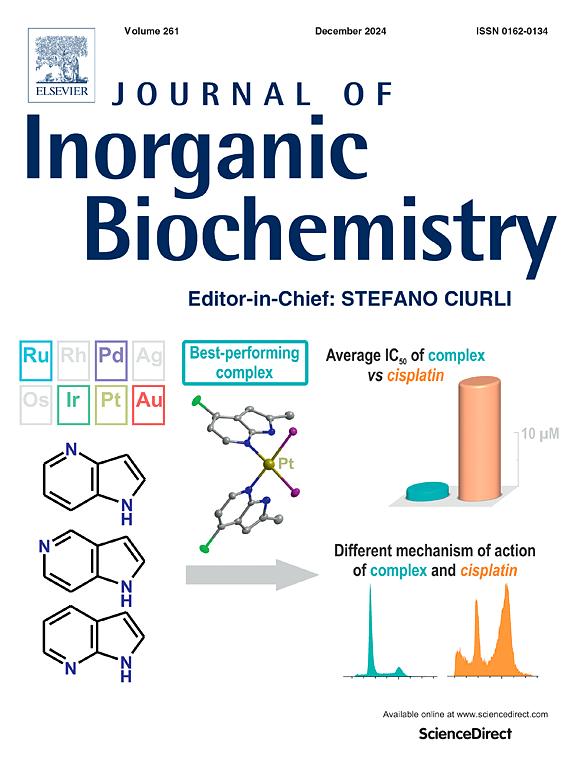铜(II)配合物与1-烯丙咪唑通过减弱Wnt、JAK-STAT和TGF-β信号通路诱导G2/M细胞周期阻滞,抑制A549癌细胞生长
IF 3.8
2区 化学
Q2 BIOCHEMISTRY & MOLECULAR BIOLOGY
引用次数: 0
摘要
本研究的主要目的是研究潜在抗癌剂铜(II)与1-烯丙咪唑[Cu(1-allim)4(NO3)2]配合物在A549肺癌细胞系上的分子作用机制,发现其对A549肺癌细胞系具有选择性细胞毒性。基因表达分析表明,该复合物通过WNT、JAK-STAT、TGF-β等途径引起细胞凋亡。该复合物诱导DNA损伤、ROS产生和线粒体膜去极化,表明其毒性可能是由于诱导内在凋亡途径。在G2/M期阻滞细胞周期。特别值得注意的是,它抑制了肺癌治疗的靶点WNT通路。其复杂的作用机制可能会阻碍癌细胞获得免疫。本文章由计算机程序翻译,如有差异,请以英文原文为准。

Copper(II) complex with 1-allylimidazole induces G2/M cell cycle arrest and suppresses A549 cancer cell growth by attenuating Wnt, JAK-STAT, and TGF-β signaling pathways
The main aim of the study was to investigate the molecular mechanism of action of the potentially anti-cancer agent copper(II) complex with 1-allylimidazole [Cu(1-allim)4(NO3)2] using the A549 lung cancer line, toward which it is selectively cytotoxic. Gene expression analysis showed that the complex caused apoptosis through WNT, JAK-STAT, and TGF-β pathways. The complex induced DNA damage, ROS production, and depolarization of the mitochondrial membrane, suggesting that its toxicity is likely due to induction of the intrinsic apoptosis pathway. It also arrested the cell cycle at G2/M phase. Particularly noteworthy is that it inhibited the WNT pathway, a target for lung cancer therapies. Its complex mechanism of action may hinder the acquisition of immunity by cancer cells.
求助全文
通过发布文献求助,成功后即可免费获取论文全文。
去求助
来源期刊

Journal of Inorganic Biochemistry
生物-生化与分子生物学
CiteScore
7.00
自引率
10.30%
发文量
336
审稿时长
41 days
期刊介绍:
The Journal of Inorganic Biochemistry is an established international forum for research in all aspects of Biological Inorganic Chemistry. Original papers of a high scientific level are published in the form of Articles (full length papers), Short Communications, Focused Reviews and Bioinorganic Methods. Topics include: the chemistry, structure and function of metalloenzymes; the interaction of inorganic ions and molecules with proteins and nucleic acids; the synthesis and properties of coordination complexes of biological interest including both structural and functional model systems; the function of metal- containing systems in the regulation of gene expression; the role of metals in medicine; the application of spectroscopic methods to determine the structure of metallobiomolecules; the preparation and characterization of metal-based biomaterials; and related systems. The emphasis of the Journal is on the structure and mechanism of action of metallobiomolecules.
 求助内容:
求助内容: 应助结果提醒方式:
应助结果提醒方式:


